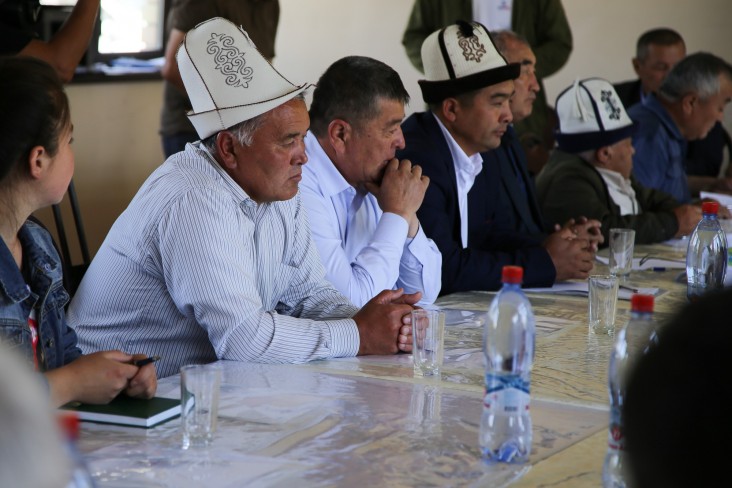Speeches Shim

USAID supports transboundary water conservation in Central Asia
When the barn on his farm caught fire in 2012, Akmyrza Masalbekov had to watch it burn. “There was no water to put out the flames,” he says.
He resolved to never let that happen again. But the solution would need more than just determination.
A History Tied to Water
Akmyrza’s home in the Zherge-Tal village is located in the traditional heartlands of the Kyrgyz nomads, in the valleys and foothills of the Tian-Shan Mountains between Issyk-Kul Lake and the Fergana Valley.
In desperate need of food more than a century ago, villagers here once dug a canal to get water from the Padysha-Ata River. They dug for four years, completing the 4.8 kilometer Uspenovka canal in 1880. In return, fields and orchards with black plums and potatoes flourished. Since then, the canal has remained unchanged. Yet a lot has happened around it.
A Tumultuous History
Over time, the Uspenovka canal became the main source of water for a growing community. Even when in dire need of repair, the earthen canal supported more than 600 hectares of land for over 1,000 families.
When the Soviet Union collapsed and its republics became independent nations, international borders were drawn across more than 200 rivers, including the Padysha-Ata. The Uspenovka canal was now located in Kyrgyzstan, across the border from the river that fed it in Uzbekistan (where it is known as the Padshata River).
This led to formidable challenges.
Central Asian countries — Kazakhstan, Kyrgyzstan, Tajikistan, Turkmenistan, and Uzbekistan — suddenly had to manage shared water resources. Most management decisions were assessed locally — not basin-wide. Monitoring became inconsistent, water losses substantial, and conflict common. The environment suffered and problems were rarely resolved.
The canal personified this struggle. “We could withdraw 500 liters per second of water from the river, but about 200 would seep away along the way,” says Akmyrza. In times of shortages, people had to wait their turn for water. “Sometimes about 30 or 40 had to share as little as 10 liters,” per day he says. People had to stop growing staple crops like potatoes, cucumber, and garlic.
A New Approach to Water Management
In 2015, the USAID-funded Smart Waters project launched in Central Asia. The project helps resolve transboundary water management problems by coordinating the development and management of water, land, and related resources. The project helped create 13 small basin councils across 8 transboundary watersheds in Central Asia, where a variety of local water users collaborate to solve their water management issues.
After establishing the small basin councils, USAID’s Smart Waters project taught council members how to conduct a comprehensive, integrated baseline analysis of the basin. They used this knowledge to prioritize critical problems and then write an action plan to solve them.
For the Padysha-Ata Basin, the Uspenovka canal was at the top of the list. And by now, Akmyrza had become chairperson of the Zherge-Tal Suu Water User Association and been elected to the Kyrgyz Republic small basin council. He’d also managed to secure funding to line 1.5 kilometers of the canal with cement — but he couldn’t raise the rest of the money to have the work done.
That’s where USAID Smart Waters stepped in, funding the canal’s rehabilitation. As a result, 120 years after it was dug, the canal was upgraded with cement lining.
Akmyrza says the results have been life-changing: “People don’t have to queue for water anymore.”
They can now use as much as 400 liters of the 500 harvested from the river. USAID has funded rehabilitation of 5 kilometers of canals, and 54 hydraulic structures in the Padysha-Ata Basin, improving irrigation of 5,145 hectares of land. In other transboundary basins, roughly 1.5 kilometers of canals and water pipelines, and about 22 hydraulic structures will be fixed. This will improve irrigation of an additional 13,000 hectares in the Central Asia region, allowing farmers and communities to increase their income and secure their livelihoods.
In the Padysha-Ata, Akmyrza says people are planting potatoes, garlic, and cucumber again. For him, the improvements are particularly close to home. “Now,” he says, “I have faith that there will be water when I truly need it most.”
The U.S. Government is committed to a water-secure world, and promoting cooperation over shared waters is pivotal to reaching that goal.
About the Author
Petro Kotzé is a freelance photojournalist and communications consultant for the USAID-funded Smart Waters project.

Comment
Make a general inquiry or suggest an improvement.